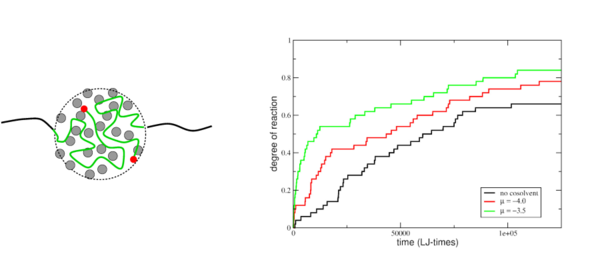Polymer-assisted condensation as reaction chambers: A model for DNA-repair
Methods: Molecular dynamics simulation, thermodynamics, phase transition theory, polymer physics
Biomolecular condensates have been observed to form localized droplets via phase separation in numerous biological systems [1]. A particular mechanism behind such a droplet formation is known as polymer-assisted condensation (PAC) [2] where polymers (DNA or RNA in biological systems) attract a cosolvent (proteins) to form a droplet, in which they remain localized inside a limited volume. We want to investigate with molecular dynamics simulations how the formation of droplets accelerates certain reactions among polymers compared to the (droplet-free) situation in the bulk.
For instance, it is known that FUS-proteins form condensates with broken DNA[3] and the absence of FUS affects DNA repair substantially, which suggest that FUS/DNA droplets are recruiting the DNA repair machinery. In this project, we will consider a simplified model, see figure, which consists of copolymers with a stiff tail (black) and a flexible head (green) with reactive end-monomers (red), which can form chemical bonds with each other. The flexible parts have an attractive interaction with the cosolvent (grey) and form droplets (dashed circle) if the bulk cosolvent concentration (or chemical potential) is sufficiently high. First simulation results show that in presence of cosolvent (red and green curves) the chain-ends react faster than in absence of cosolvent (black curve). This model should be studied in more detail to understand the role of PAC-formed droplets as reaction chambers. Besides computer simulations analytical models shall be considered to rationalize the results.
The key tasks for the project are
- Design and setup of coarse-grained molecular dynamics simulations
- Quantification of the speed up of chemical reactions due to PAC
- Identification of key-factors that are of relevance for biological systems
- Development of simplified analytical models to interpret the results
- Publication of the results in peer-reviewed journals
Key words: Polymer-assisted condensation, co-nonsolvency effect, DNA-repair, MD simulations
References:


